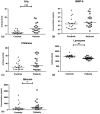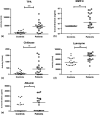Comparing periodontitis biomarkers in saliva, oral rinse and gingival crevicular fluid: A pilot study
- PMID: 33998029
- PMCID: PMC8453974
- DOI: 10.1111/jcpe.13479
Comparing periodontitis biomarkers in saliva, oral rinse and gingival crevicular fluid: A pilot study
Abstract
Aim: To explore the feasibility of screening for periodontitis by measuring biomarkers, namely total proteolytic activity (TPA), matrix metalloproteinase (MMP)-8, chitinase, lysozyme or their combination, in saliva, oral rinse and gingival crevicular fluid (GCF).
Material and methods: Subjects were recruited among healthy/gingivitis individuals and untreated periodontitis patients in Academic Centre for Dentistry Amsterdam (ACTA). All participants donated samples of unstimulated whole saliva, oral rinse and GCF. The protein concentrations and MMP-8 levels were determined by ELISA. Enzymatic activities were measured using appropriate fluorogenic substrates.
Results: In oral rinse samples, periodontitis patients (n = 19) exhibited significantly higher concentrations of MMP-8 and TPA than controls (n = 20). MMP-8 in combination with chitinase explained 88% of the variance and assigned a subject to control or periodontitis group, with best accuracy (87.2%) in oral rinse.
Conclusions: The combination of MMP-8 and chitinase in the current oral rinse procedure has the potential to discriminate periodontitis from periodontal health/gingivitis.
Keywords: MMP-8; biomarkers; chitinase; gingival crevicular fluid; modelling; oral rinse; periodontitis; principal component analysis (PCA); protease; saliva.
© 2021 The Authors. Journal of Clinical Periodontology published by John Wiley & Sons Ltd.
Conflict of interest statement
The authors declare that there are no conflicts of interest in this study.
Figures




Similar articles
-
Matrix metalloproteinases and myeloperoxidase in gingival crevicular fluid provide site-specific diagnostic value for chronic periodontitis.J Clin Periodontol. 2014 Apr;41(4):348-56. doi: 10.1111/jcpe.12223. Epub 2014 Feb 17. J Clin Periodontol. 2014. PMID: 24382144
-
Biomarkers of periodontitis in oral fluids.J Oral Sci. 2008 Mar;50(1):53-6. doi: 10.2334/josnusd.50.53. J Oral Sci. 2008. PMID: 18403884
-
Origin of MMP-8 and Lactoferrin levels from gingival crevicular fluid, salivary glands and whole saliva.BMC Oral Health. 2021 Aug 5;21(1):385. doi: 10.1186/s12903-021-01743-5. BMC Oral Health. 2021. PMID: 34353321 Free PMC article.
-
The emerging role of small extracellular vesicles in saliva and gingival crevicular fluid as diagnostics for periodontitis.J Periodontal Res. 2022 Jan;57(1):219-231. doi: 10.1111/jre.12950. Epub 2021 Nov 13. J Periodontal Res. 2022. PMID: 34773636 Review.
-
Analysis of matrix metalloproteinases, especially MMP-8, in gingival creviclular fluid, mouthrinse and saliva for monitoring periodontal diseases.Periodontol 2000. 2016 Feb;70(1):142-63. doi: 10.1111/prd.12101. Periodontol 2000. 2016. PMID: 26662488 Review.
Cited by
-
Active Matrix Metalloproteinase-8 (aMMP-8) Versus Total MMP-8 in Periodontal and Peri-Implant Disease Point-of-Care Diagnostics.Biomedicines. 2023 Oct 25;11(11):2885. doi: 10.3390/biomedicines11112885. Biomedicines. 2023. PMID: 38001886 Free PMC article.
-
Macrophages induce gingival destruction via Piezo1-mediated MMPs-degrading collagens in periodontitis.Front Immunol. 2023 May 16;14:1194662. doi: 10.3389/fimmu.2023.1194662. eCollection 2023. Front Immunol. 2023. PMID: 37261355 Free PMC article.
-
Preventive and Therapeutic Potential of Streptococcus cristatus CA119 in Experimental Periodontitis in Rats.Probiotics Antimicrob Proteins. 2024 Apr 12. doi: 10.1007/s12602-024-10254-y. Online ahead of print. Probiotics Antimicrob Proteins. 2024. PMID: 38607584
-
Probiotics Partly Suppress the Impact of Sugar Stress on the Oral Microbiota-A Randomized, Double-Blinded, Placebo-Controlled Trial.Nutrients. 2023 Nov 17;15(22):4810. doi: 10.3390/nu15224810. Nutrients. 2023. PMID: 38004205 Free PMC article. Clinical Trial.
-
aMMP-8 and MMP-9: Potential Biomarkers for periodontitis Progression in Patients Receiving Radiotherapy for Head and Neck Carcinoma.Cancer Control. 2025 Jan-Dec;32:10732748251351419. doi: 10.1177/10732748251351419. Epub 2025 Jun 22. Cancer Control. 2025. PMID: 40545647 Free PMC article.
References
-
- Arias‐Bujanda, N., Regueira‐Iglesias, A., Balsa‐Castro, C., Nibali, L., Donos, N., & Tomas, I. (2019). Accuracy of single molecular biomarkers in saliva for the diagnosis of periodontitis: A systematic review and meta‐analysis. Journal of Clinical Periodontology, 47(1), 2–18. 10.1111/jcpe.13202 - DOI - PubMed
-
- Bikker, F. J., Nascimento, G. G., Nazmi, K., Silbereisen, A., Belibasakis, G. N., Kaman, W. E., Lopez, R., & Bostanci, N. (2019). Salivary total protease activity based on a broad‐spectrum fluorescence resonance energy transfer approach to monitor induction and resolution of gingival inflammation. Molecular Diagnosis & Therapy, 23(5), 667–676. 10.1007/s40291-019-00421-1 - DOI - PMC - PubMed
Publication types
MeSH terms
Substances
LinkOut - more resources
Full Text Sources
Other Literature Sources

